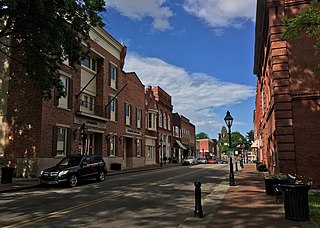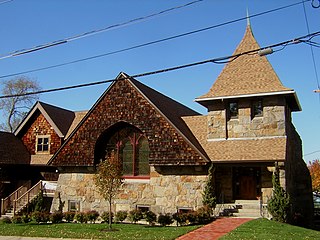
Rogersville is a town in, and the county seat of, Hawkins County, Tennessee, United States. It was settled in 1775 by the grandparents of Davy Crockett. It is named for its founder, Joseph Rogers. Tennessee's second oldest courthouse, the Hawkins County Courthouse, first newspaper The Knoxville Gazette, and first post office are all located in Rogersville. The Rogersville Historic District is listed on the National Register of Historic Places.

Westminster Hall and Burying Ground is a graveyard and former church located at 519 West Fayette Street in Baltimore, Maryland, United States. It is currently part of the grounds of the University of Maryland's School of Law. It occupies the southeast corner of West Fayette and North Greene Street on the west side of downtown Baltimore. It sits across from the Baltimore VA hospital and is the burial site of Edgar Allan Poe (1809–1849). The complex was declared a national historic district in 1974.

Second Presbyterian Church is a landmark Gothic Revival church located on South Michigan Avenue in Chicago, Illinois, United States. In the late nineteenth and early twentieth centuries, some of Chicago's most prominent families attended this church. It is renowned for its interior, completely redone in the Arts and Crafts style after a disastrous fire in 1900. The sanctuary is one of America's best examples of an unaltered Arts and Crafts church interior, fully embodying that movement's principles of simplicity, hand craftsmanship, and unity of design. It also boasts nine imposing Tiffany windows. The church was listed on the National Register of Historic Places in 1974 and later designated a Chicago Landmark on September 28, 1977. It was designated a National Historic Landmark in March 2013.

The Downtown Presbyterian Church in Nashville, Tennessee, a part of the Presbyterian Church (USA), was formerly known as First Presbyterian Church. The church is located at the corner of Rep. John Lewis Way and Church Street. As Old First Presbyterian Church it was designated a National Historic Landmark in 1993, for its distinctive Egyptian Revival architecture.
Architecture in Omaha, Nebraska, represents a range of cultural influences and social changes occurring from the late 19th century to present.

Church Street United Methodist Church is a United Methodist church located on Henley Street in downtown Knoxville, Tennessee. The church building is considered a Knoxville landmark and is listed on the National Register of Historic Places.

Price Public Elementary School, now known as Price Public Community Center and Swift Museum, is a former African-American school in Rogersville, Tennessee. It currently serves as a community center and home of the Swift Museum. The school was listed on the National Register of Historic Places in 1988.

St. Mark's Episcopal Church is an historic Episcopal church located at 6-8 Highland Street in Ashland, New Hampshire, in the United States. Organized in 1855, it is part of the Episcopal Diocese of New Hampshire. Its building, completed in 1859, was designed by New York City architect J. Coleman Hart, and is one of the region's most distinctive churches, having a Gothic Revival design built out of half-timbered brick. On December 13, 1984, the church building was added to the National Register of Historic Places. The current pastor is Rev. Tobias Nyatsambo.
William Halsey Wood was an American architect.

The Wollaston Unitarian Church, more recently a former home of the St. Catherine's Greek Orthodox Church, is a historic church building at 155 Beale Street in Quincy, Massachusetts. Built in 1888 to a design by Edwin J. Lewis Jr., it is a prominent local example of Shingle Style architecture. It was added to the National Register of Historic Places in 1989. The building has been converted to residential use.

First Presbyterian Church and Manse is a historic Presbyterian church located at West Madison Street and Park Avenue in the Mount Vernon-Belvedere neighborhood of Baltimore, Maryland, United States. The church is a rectangular brick building with a central tower flanked by protruding octagonal turrets at each corner. At the north end of the church is a two-story building appearing to be a transept and sharing a common roof with the church, but is separated from the auditorium by a bearing wall. The manse is a three-story stone-faced building. The church was begun about 1854 by Norris G. Starkweather and finished by his assistant Edmund G. Lind around 1873. It is a notable example of Gothic Revival architecture and a landmark in the City of Baltimore.

St. Paul's Episcopal Church in Chattanooga, Tennessee, is a downtown congregation of the Episcopal Church. It is one of the largest congregations in the Episcopal Diocese of East Tennessee.

The Memorial Presbyterian Church is a historic church constructed in St. Augustine, Florida, in 1889 by American industrialist Henry Morrison Flagler. It is located at 32 Sevilla Street. It was dedicated to the memory of his daughter Jennie Louise Benedict, who died following complications from childbirth at sea in March 1889.

Capers C.M.E. Church, is a historic Christian Methodist Episcopal church built in 1925 in Nashville, Tennessee. It is also known as Caper Memorial Christian Church, and Capers Memorial C.M.E. Church.

New Providence Presbyterian Church is a historic church in Surgoinsville, Tennessee, United States, affiliated with Presbyterian Church (USA).

Mt. Zion Christian Methodist Episcopal Church, formerly Mt. Zion Colored Methodist Episcopal Church, is a historic African-American church in Union City, Tennessee, at the corner of North Greenwood and East College Streets.

The Julia Morgan Theater, located in the former St. John's Presbyterian Church, is a historic building in Berkeley, California designed by architect Julia Morgan. The wooden building at 2640 College Avenue is built in the American Craftsman style with an exterior wood-shingle finish known as Berkeley Brown Shingle. The church building was desanctified and sold when the congregation moved to a new building in 1974. It now houses the Berkeley Playhouse. The structure is #8 on the city of Berkeley's list of historic landmarks. In 1975 it was added to the National Register of Historic Places.

The Owen Chapel Church of Christ is a property in Brentwood, Tennessee that was built c. 1860 and that was listed on the National Register of Historic Places in 1986. It includes Greek Revival and "Vernacular Greek Revival" architecture.

Swift Memorial College was a private historically Black college established by the Presbyterian church that operated from 1883 to 1952, in Rogersville, Tennessee, United States. It was established after a state law ended access for African Americans to Maryville College. Like many other early HBCU's, the school curricula in the early years was focused on high school and normal school; later it operated as a junior college. It also served as a boarding school. It closed after desegregation.

Rev. William Henderson Franklin (1852–1935) was an American educator, minister, journalist, and school founder. Franklin dedicated his life to the education of Black children in rural Tennessee during the time of racial segregation. He founded Swift Memorial College in 1883, and served as the principal until 1926; and he first minister the congregation at St. Marks Presbyterian Church in Rogersville, Tennessee. He was also known as W.H. Franklin.




















